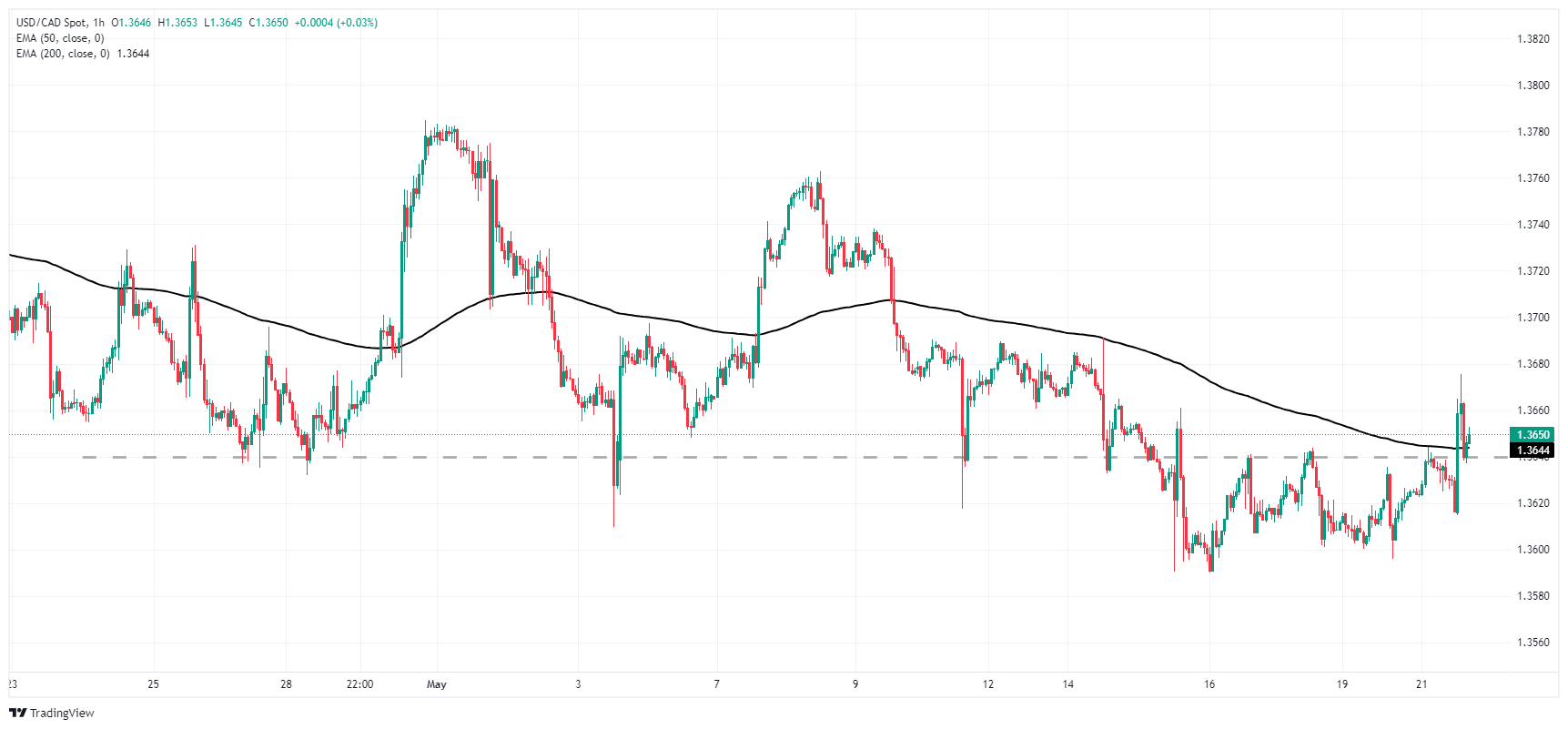Canadian Dollar eases back on Tuesday after CPI inflation cools

- Canadian Dollar moves broadly lower as inflation tempers in April.
- Canada finds easing price pressures, odds of BoC June rate cut rise.
- Canadian Retail Sales due at end of this week.
The Canadian Dollar (CAD) is broadly softer on Tuesday, falling across the board and deflating by around a fifth of a percent against the US Dollar (USD) after Canadian Consumer Price Index (CPI) inflation eased further in April. Markets are increasing their bets of a rate cut from the Bank of Canada (BoC) in June.
Canadian CPI inflation eased broadly in line with expectations, but the BoC’s Core CPI print dropped to its lowest point since April of 2021. With price pressure easing, market bets of a June rate cut from the BoC have risen to 48% from 40% prior to Canada’s CPI print.
Daily digest market movers: Canadian Dollar slides in face of easing inflation
- Canadian headline CPI inflation in April ticked down to 0.5% MoM, matching forecasts and easing from the previous 0.6%.
- YoY Canadian CPI inflation also met market forecasts, printing at 2.7% versus the previous 2.9%.
- The BoC’s Core CPI for the year ended April eased to 1.6%, down from the previous 2.0% and hitting a three-year low.
- Fedspeak continues to dominate overall sentiment as policymakers from the US Federal Reserve make a slew of appearances in an effort to inject verbal confidence in markets.
- Canadian Retail Sales are due at the end of the week. Median market forecasts are hoping for a slight rebound to a flat reading from the previous -0.1%.
Canadian Dollar PRICE Today
The table below shows the percentage change of Canadian Dollar (CAD) against listed major currencies today. Canadian Dollar was the strongest against the New Zealand Dollar.
| USD | EUR | GBP | JPY | CAD | AUD | NZD | CHF | |
|---|---|---|---|---|---|---|---|---|
| USD | 0.00% | -0.04% | -0.08% | 0.16% | 0.01% | 0.16% | 0.00% | |
| EUR | -0.01% | -0.04% | -0.08% | 0.14% | 0.04% | 0.13% | 0.01% | |
| GBP | 0.04% | 0.04% | -0.06% | 0.20% | 0.05% | 0.19% | 0.04% | |
| JPY | 0.08% | 0.08% | 0.06% | 0.25% | 0.08% | 0.22% | 0.08% | |
| CAD | -0.16% | -0.14% | -0.20% | -0.25% | -0.15% | -0.01% | -0.16% | |
| AUD | -0.01% | -0.04% | -0.05% | -0.08% | 0.15% | 0.14% | 0.00% | |
| NZD | -0.16% | -0.13% | -0.19% | -0.22% | 0.01% | -0.14% | -0.15% | |
| CHF | -0.00% | -0.01% | -0.04% | -0.08% | 0.16% | 0.00% | 0.15% |
The heat map shows percentage changes of major currencies against each other. The base currency is picked from the left column, while the quote currency is picked from the top row. For example, if you pick the Canadian Dollar from the left column and move along the horizontal line to the US Dollar, the percentage change displayed in the box will represent CAD (base)/USD (quote).
Technical analysis: Canadian Dollar backslides but remains in familiar technical territory
The Canadian Dollar (CAD) is moving in one direction on Tuesday, heading lower against nearly all of its major currency peers. The CAD is down a third of a percent against the broadly-recovering Japanese Yen (JPY) and has shed a fifth of a percent against the USD.
USD/CAD rose to its highest bids in a week, threatening to solidify a bullish rejection from the 50-day Exponential Moving Average (EMA) from 1.3636. The pair is still down from last month’s peak bids near 1.3850, but a long-term technical floor is priced in at the 200-day EMA from 1.3549.
USD/CAD hourly chart
USD/CAD daily chart
Inflation FAQs
Inflation measures the rise in the price of a representative basket of goods and services. Headline inflation is usually expressed as a percentage change on a month-on-month (MoM) and year-on-year (YoY) basis. Core inflation excludes more volatile elements such as food and fuel which can fluctuate because of geopolitical and seasonal factors. Core inflation is the figure economists focus on and is the level targeted by central banks, which are mandated to keep inflation at a manageable level, usually around 2%.
The Consumer Price Index (CPI) measures the change in prices of a basket of goods and services over a period of time. It is usually expressed as a percentage change on a month-on-month (MoM) and year-on-year (YoY) basis. Core CPI is the figure targeted by central banks as it excludes volatile food and fuel inputs. When Core CPI rises above 2% it usually results in higher interest rates and vice versa when it falls below 2%. Since higher interest rates are positive for a currency, higher inflation usually results in a stronger currency. The opposite is true when inflation falls.
Although it may seem counter-intuitive, high inflation in a country pushes up the value of its currency and vice versa for lower inflation. This is because the central bank will normally raise interest rates to combat the higher inflation, which attract more global capital inflows from investors looking for a lucrative place to park their money.
Formerly, Gold was the asset investors turned to in times of high inflation because it preserved its value, and whilst investors will often still buy Gold for its safe-haven properties in times of extreme market turmoil, this is not the case most of the time. This is because when inflation is high, central banks will put up interest rates to combat it. Higher interest rates are negative for Gold because they increase the opportunity-cost of holding Gold vis-a-vis an interest-bearing asset or placing the money in a cash deposit account. On the flipside, lower inflation tends to be positive for Gold as it brings interest rates down, making the bright metal a more viable investment alternative.
Information on these pages contains forward-looking statements that involve risks and uncertainties. Markets and instruments profiled on this page are for informational purposes only and should not in any way come across as a recommendation to buy or sell in these assets. You should do your own thorough research before making any investment decisions. FXStreet does not in any way guarantee that this information is free from mistakes, errors, or material misstatements. It also does not guarantee that this information is of a timely nature. Investing in Open Markets involves a great deal of risk, including the loss of all or a portion of your investment, as well as emotional distress. All risks, losses and costs associated with investing, including total loss of principal, are your responsibility. The views and opinions expressed in this article are those of the authors and do not necessarily reflect the official policy or position of FXStreet nor its advertisers. The author will not be held responsible for information that is found at the end of links posted on this page.
If not otherwise explicitly mentioned in the body of the article, at the time of writing, the author has no position in any stock mentioned in this article and no business relationship with any company mentioned. The author has not received compensation for writing this article, other than from FXStreet.
FXStreet and the author do not provide personalized recommendations. The author makes no representations as to the accuracy, completeness, or suitability of this information. FXStreet and the author will not be liable for any errors, omissions or any losses, injuries or damages arising from this information and its display or use. Errors and omissions excepted.
The author and FXStreet are not registered investment advisors and nothing in this article is intended to be investment advice.




